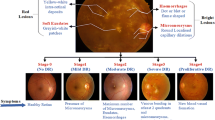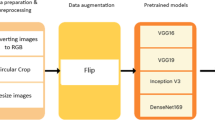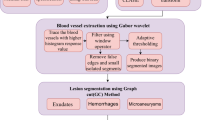Abstract
Diabetes mellitus Retinopathy (DR) has recently become a major health problem, and its complications are also increasing worldwide. Early diagnosis of DR is essential to determine the significance of several features from fundus images for detection and classification in many Computer-Aided Diagnosis (CAD) applications. However, existing methods suffer from high dimensional features, small training datasets, misclassification, and high training loss, which leads to a complex grading system. Aiming at these concerns, this paper presents a Frame-wise Severity Scale Classification Model (FSSCM) using Transfer Learning enabled EfficientNet B3 and Fine Tuning enabled ResNet 101, namely, TL-EN3 and FT-RN 101, to classify the severity of disease level of retinal fundus images. Initially, the preprocessing and augmentation processes are performed to bring out the clear view features of the raw fundus images. Then the segmentation phase constrains the whole region using the Chan-Vese algorithm. Twelve features are extracted and fed into the learning network for training purposes. The proposed work utilizes the TL-EN3 model to capture high-resolution patterns with high accuracy and integrates FT-RN 101 models to maintain a balance between efficiency and accuracy with fewer parameters. Experimental analysis is conducted with different metrics such as kappa coefficient (K-score), classification accuracy (CA), precision (P), recall (R), F1-measure (F1), and False Positive Rate (FPR) on three publically available datasets such as Kaggle, Messidor-1, and Messidor-2 datasets. Furthermore, some performance graphs are plotted for visualizing the architecture performance, including training loss, validation loss, training accuracy, and validation accuracy. The performance of the proposed FSSCM approach obtains high estimation values of 0.981 0.985 0.983, 0.98 0.986 0.984, and 0.98 0.985 0.98 in terms of P, R, and F1 on three datasets, respectively. Also, it achieves high estimation results of 99.02 0.993, 98.1 0.97, and 98.3 0.98 in terms of CA and K-score for three datasets, respectively. With a high training accuracy and a low level of training loss, the proposed method gets better severity level classification results than other models.






Similar content being viewed by others
Data availability
All authors contributed to the study conception and design. Material preparation, data collection and analysis were performed by Sachin Chavan, Nitin Choubey. The first draft of the manuscript was written by Sachin Chavan and all authors commented on previous versions of the manuscript. All authors read and approved the final manuscript.
Code availability
Not Applicable.
References
Alzami F, Megantara RA, Fanani AZ (2019) Diabetic retinopathy grade classification based on fractal analysis and random forest. In2019 international seminar on application for Technology of Information and Communication (iSemantic) (pp. 272-276). IEEE
Bhatkar AP, Kharat GU (2015) Detection of diabetic retinopathy in retinal images using MLP classifier. In2015 IEEE international symposium on nanoelectronic and information systems. (pp. 331-335). IEEE
Cetinic E, Lipic T, Grgic S (2018) Fine-tuning convolutional neural networks for fine art classification. Expert Syst Appl 114:107–118
Cho N, Shaw JE, Karuranga S, Huang YD, da Rocha Fernandes JD, Ohlrogge AW, Malanda B (2018) IDF diabetes atlas: global estimates of diabetes prevalence for 2017 and projections for 2045. Diabetes Res Clin Pract 138:271–281
Costa P, Galdran A, Smailagic A, Campilho A (2018) A weakly-supervised framework for interpretable diabetic retinopathy detection on retinal images. IEEE Access 6:18747–18758
Cui X, Zhang W, Tüske Z, Picheny M (2018) Evolutionary stochastic gradient descent for optimization of deep neural networks. arXiv preprint arXiv:1810.06773
Daniel K, Michael G, Wenjia C et al (2018) Kaggle Dataset. https://www.kaggle.com/c/diabetic-retinopathy-detection/data
Das S, Kharbanda K, Suchetha M, Raman R, Dhas E (2021) Deep learning architecture based on segmented fundus image features for classification of diabetic retinopathy. Biomed Signal Process Control 68:102600
Doshi D, Shenoy A, Sidhpura D, Gharpure P (2016) Diabetic retinopathy detection using deep convolutional neural networks. In2016 international conference on computing, analytics and security trends (CAST) (pp. 261-266). IEEE
Gayathri S, Gopi VP, Palanisamy P (2020) Automated classification of diabetic retinopathy through reliable feature selection. Phys Eng Sci Med 43(3):927–945
Gayathri S, Krishna AK, Gopi VP, Palanisamy P (2020) Automated binary and multiclass classification of diabetic retinopathy using haralick and multiresolution features. IEEE Access 8:57497–57504
Gayathri S, Gopi VP, Palanisamy P (2020) A lightweight CNN for diabetic retinopathy classification from fundus images. Biomed Signal Process Control 62:102115
Gayathri S, Gopi VP, Palanisamy P (2021) Diabetic retinopathy classification based on multipath CNN and machine learning classifiers. Phys Eng Sci Med 44(3):639–653
Gupta A, Chhikara R (2018) Diabetic retinopathy: present and past. Procedia Comput Sci 132:1432–1440
Hemanth DJ, Deperlioglu O, Kose U (2020) An enhanced diabetic retinopathy detection and classification approach using deep convolutional neural network. Neural Comput & Applic 32(3):707–721
Hussain M, Bird JJ, Faria DR (2018) A study on cnn transfer learning for image classification. InUK workshop on computational intelligence. (pp. 191-202). Springer, Cham
Ishtiaq U, Kareem SA, Abdullah ER, Mujtaba G, Jahangir R, Ghafoor HY (2020) Diabetic retinopathy detection through artificial intelligent techniques: a review and open issues. Multimed Tools Appl 79(21):15209–15252
Islam M, Dinh AV, Wahid KA (2017) Automated diabetic retinopathy detection using bag of words approach. J Biomed Sci Eng 10(5):86–96
Islam MM, Yang HC, Poly TN, Jian WS, Li YC (2020) Deep learning algorithms for detection of diabetic retinopathy in retinal fundus photographs: a systematic review and meta-analysis. Comput Methods Prog Biomed 191:105320
Jebaseeli TJ, Durai CA, Peter JD (2019) Retinal blood vessel segmentation from diabetic retinopathy images using tandem PCNN model and deep learning based SVM. Optik. 199:163328
Kandel I, Castelli M (2020) Transfer learning with convolutional neural networks for diabetic retinopathy image classification. A review. Appl Sci 10(6):2021
Kassani SH, Kassani PH, Khazaeinezhad R, Wesolowski MJ, Schneider KA, Deters R (2019) Diabetic retinopathy classification using a modified xception architecture. In2019 IEEE international symposium on signal processing and information technology (ISSPIT). IEEE, pp 1–6
Krizhevsky A, et al. (2012) Imagenet classification with deep convolutional neural networks. Adv Neural Inf Process Syst 1097–1105
Lam C, et al. (2018) Automated detection of diabetic retinopathy using deep learning. AMIA summits on translational science proceedings. 147-155
Lam C, Yi D, Guo M, Lindsey T (2018) Automated detection of diabetic retinopathy using deep learning. AMIA Summits Transl Sci Proceed 2018:147
Li F et al (2019) Automatic detection of diabetic retinopathy in retinal fundus photographs based on deep learning algorithm. Translat Vis Sci Technol 8(6):4, 1–4,13
Li YH, Yeh NN, Chen SJ, Chung YC (2019) Computer-assisted diagnosis for diabetic retinopathy based on fundus images using deep convolutional neural network. Mob Inf Syst
Memari N, Saripan MI, Mashohor S, Moghbel M (2019) Retinal blood vessel segmentation by using matched filtering and fuzzy c-means clustering with integrated level set method for diabetic retinopathy assessment. J Med Biol Eng 39(5):713–731
Messidor 2 Dataset (n.d.) https://www.adcis.net/en/third-party/messidor2/
Messidor Dataset (n.d.) https://www.adcis.net/en/third-party/messidor/
Mookiah MR, Acharya UR, Chua CK, Lim CM, Ng EY, Laude A (2013) Computer-aided diagnosis of diabetic retinopathy: a review. Comput Biol Med 43(12):2136–2155
Nair M, Mishra D (2019) Classification of diabetic retinopathy severity levels of transformed images using K-means and thresholding method. Int J Eng Adv Technol 8(4):51–59
Narasimhan K, Neha VC, Vijayarekha K (2012) An efficient automated system for detection of diabetic retinopathy from fundus images using support vector machine and bayesian classifiers. In2012 international conference on computing, electronics and electrical technologies (ICCEET). IEEE, pp 964–969
Qiao L, Zhu Y, Zhou H (2020) Diabetic retinopathy detection using prognosis of microaneurysm and early diagnosis system for non-proliferative diabetic retinopathy based on deep learning algorithms. IEEE Access 8:104292–104302
Qomariah DU, Tjandrasa H, Fatichah C (2019) Classification of diabetic retinopathy and normal retinal images using CNN and SVM. In: 2019 12th international conference on Information & Communication Technology and system (ICTS). IEEE, pp 152–157
Rahman Z, Pu YF, Aamir M, Ullah F (2019) A framework for fast automatic image cropping based on deep saliency map detection and gaussian filter. International. J Comput Appl 41(3):207–217
Riaz H, Park J, Choi H, Kim H, Kim J (2020) Deep and densely connected networks for classification of diabetic retinopathy. Diagnostics. 10(1):24
Roychowdhury A, Banerjee S (2018) Random forests in the classification of diabetic retinopathy retinal images. InAdvanced computational and communication paradigms: Proceedings of International Conference on ICACCP 2017, vol 1. Springer, Singapore, pp 168–176
Sayres R, Taly A, Rahimy E, Blumer K, Coz D, Hammel N, Krause J, Narayanaswamy A, Rastegar Z, Wu D, Xu S (2019) Using a deep learning algorithm and integrated gradients explanation to assist grading for diabetic retinopathy. Ophthalmology. 126(4):552–564
Seewoodhary M (2020) An overview of diabetic retinopathy and other ocular complications of diabetes mellitus. Eye
Selvathi D, Prakash NB, Balagopal N (n.d.) Automated detection of diabetic retinopathy for early diagnosis using feature extraction and support vector machine
Shankar K, Perumal E, Vidhyavathi RM (2020) Deep neural network with moth search optimization algorithm based detection and classification of diabetic retinopathy images. SN Appl Sci 2:1–0
Shanthi T, Sabeenian RS (2019) Modified Alexnet architecture for classification of diabetic retinopathy images. Comput Electr Eng 76:56–64
Szegedy C, Liu W, Jia Y, Sermanet P, Reed S, Anguelov D, Erhan D, Vanhoucke V, Rabinovich A (2015) Going deeper with convolutions. In: Proceedings of the IEEE conference on computer vision and pattern recognition, pp 1–9
Tan M, Le Q (2019) Efficientnet: rethinking model scaling for convolutional neural networks. In: International conference on machine learning. PMLR, pp 6105–6114
Targ S, Almeida D, Lyman K (2016) Resnet in resnet: generalizing residual architectures. arXiv preprint arXiv:1603.08029
Vijayan T, Sangeetha M, Kumaravel A, Karthik B (2020) Gabor filter and machine learning based diabetic retinopathy analysis and detection. Microprocess Microsyst 103353. https://doi.org/10.1016/j.micpro.2020.103353
Wu Z, Shi G, Chen Y, Shi F, Chen X, Coatrieux G, Yang J, Luo L, Li S (2020) Coarse-to-fine classification for diabetic retinopathy grading using convolutional neural network. Artif Intell Med 108:101936
Zaaboub N, Douik A (2020) Early diagnosis of diabetic retinopathy using random Forest algorithm. In: 2020 5th international conference on advanced Technologies for Signal and Image Processing (ATSIP). IEEE, pp 1–5
Zago GT, Andreão RV, Dorizzi B, Salles EO (2020) Diabetic retinopathy detection using red lesion localization and convolutional neural networks. Comput Biol Med 116:103537
Zeng X, Chen H, Luo Y, Ye W (2019) Automated diabetic retinopathy detection based on binocular siamese-like convolutional neural network. IEEE Access 7:30744–30753
Zimmet P, Alberti KG, Magliano DJ, Bennett PH (2016) Diabetes mellitus statistics on prevalence and mortality: facts and fallacies. Nat Rev Endocrinol 12(10):616–622
Author information
Authors and Affiliations
Contributions
All the authors have participated in writing the manuscript and have revised the final version. All authors read and approved the final manuscript.
Conceptualization: Sachin Chavan; Methodology: Sachin Chavan, Nitin Choubey; Formal analysis and investigation: Sachin Chavan, Nitin Choubey; Writing - original draft preparation: Sachin Chavan; Writing - review and editing: Sachin Chavan; Supervision: Nitin Choubey.
Corresponding author
Ethics declarations
Ethics approval
This article does not contain any studies with human participants and/or animals performed by any of the authors.
Informed consent
There is no informed consent for this study.
Conflict of interest
Authors declares that they have no conflict of interest.
Additional information
Publisher’s note
Springer Nature remains neutral with regard to jurisdictional claims in published maps and institutional affiliations.
Rights and permissions
Springer Nature or its licensor (e.g. a society or other partner) holds exclusive rights to this article under a publishing agreement with the author(s) or other rightsholder(s); author self-archiving of the accepted manuscript version of this article is solely governed by the terms of such publishing agreement and applicable law.
About this article
Cite this article
Chavan, S., Choubey, N. An automated diabetic retinopathy of severity grade classification using transfer learning and fine-tuning for fundus images. Multimed Tools Appl 82, 36859–36884 (2023). https://doi.org/10.1007/s11042-023-15135-0
Received:
Revised:
Accepted:
Published:
Issue Date:
DOI: https://doi.org/10.1007/s11042-023-15135-0




